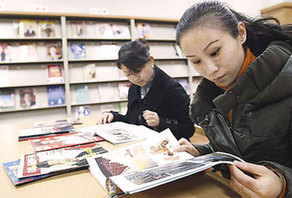
Yuci Culture Art Center is a popular place for locals to spend their free time.
|
|
|
Yuci Culture Art Center is a popular place for locals to spend their free time. |
|
|
|
Shanxi Museum guide Han Jingwei enjoys working with the province's cultural relics. |
Han Jingwei says she goes to heaven every day - that is, when she clocks in at work.
The 28-year-old from Shanxi's provincial capital Taiyuan says her job as a museum guide at Shanxi Museum is one, "I love with all my heart". So every day she has worked for the past three years are days spent in "paradise", she says.
"There is a Chinese saying that one day in heaven equals a year on Earth," Han says.
"The museum is even better than heaven. So a day at work equals 5,000 years on earth. I love history, and the work is perfect for me."
She starts every morning undertaking training with 20 other women guides, who memorize facts about the displays and practice Mandarin.
Shanxi Museum is the province's largest at 51,000 square meters, and houses more than 400,000 relics.
It was completed in 2005 on the west bank of Taiyuan's Fenhe River. It received more than 1 million visitors - equal to a third of the city's population - in 2011.
Han explains the exhibits to elderly people using walkers and wheelchairs, a woman pushing a stroller and two primary school girls, who scribble notes as they study two Buddhist statues in a glass case.
Han says she never tires of spending every day telling the same stories in the same seven halls.
"I feel like I'm wandering through a time warp when I walk here," she says.
"I'm proud of the relics unearthed in my hometown and feel blessed Taiyuan has such a great museum."
Plans for the museum were floated in 1997 to chronicle Shanxi's place as the cradle of Chinese civilization - a civilization spawned from the state of Jin that existed in the area during the Spring and Autumn Period (770-476 BC).
"Shanxi is rich in culture, and many archeological treasures have been discovered since the 1980s," deputy director Zhao Shuguang says.
"So it's necessary to have a comprehensive museum to share our history."
Local authorities decided to bring in Shanxi Architecture Design Institute designer Zhao Youting to create a hypermodern structure in which to showcase the ancient wonders. Construction began in 2001.
The museum uses some of the 30 million yuan ($4.7 million) it receives in annual government support to send guides to give lectures in local schools and communities.
The museum will in 2012 host 15 exhibitions, including those of Zhang Daqian's paintings and relics from Gansu province's ancient Dunhuang.
Han's enthusiasm for the museum is shared by many, including middle school history teacher Hu Bin.
The 34-year-old visited many Beijing museums when he studied law in the capital from 1998 to 2000.
"Before the Shanxi Museum was built, Taiyuan only had a temple called the Shanxi Art Museum," he recalls.
"I want to explore Shanxi and our country more as a historian. Now I have a place to access that dream."
But that's not the best part for Hu.
"The museum brings ordinary people closer to history," he says.